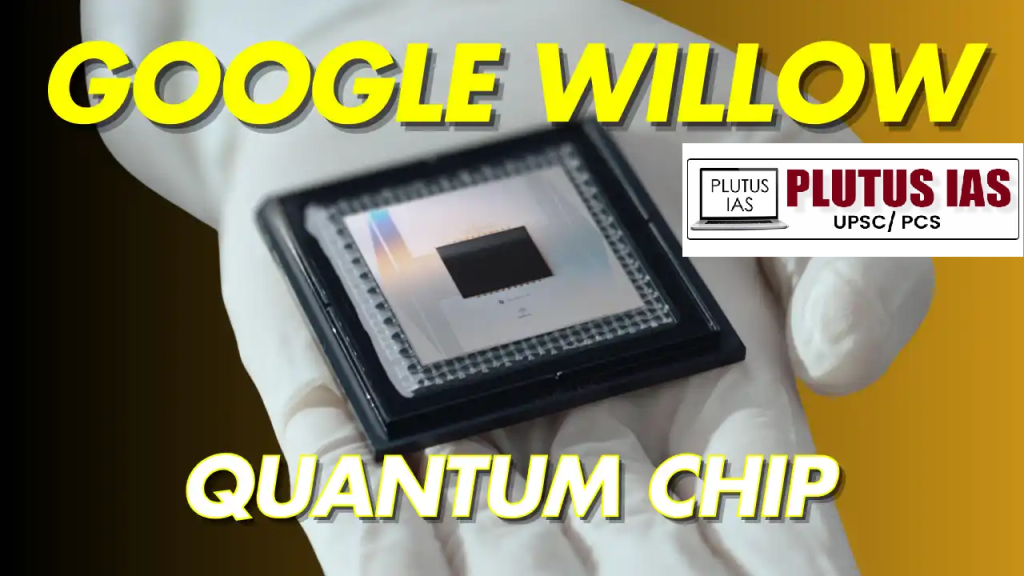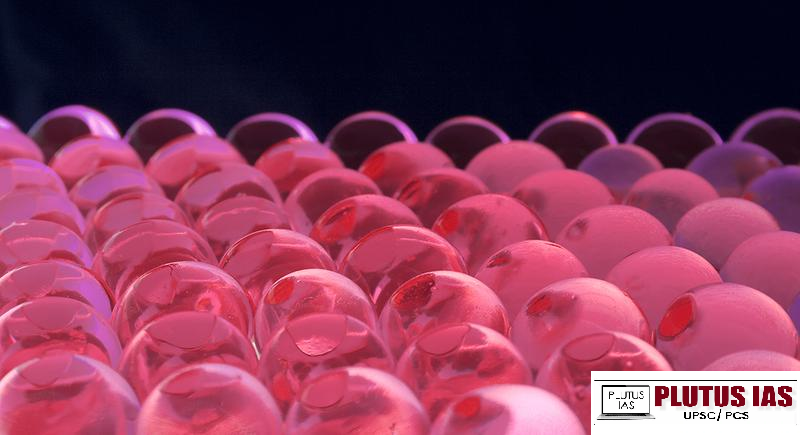10 Jan Google Willow Quantum Chip, Hydrogel
SYLLABUS MAPPING:
GS-3-Science and technology-Google Willow Quantum Chip
FOR PRELIMS:
What is Quantum Chip and its features?
FOR MAINS
What are the applications of Quantum technology in various fields
Why in the news?
Google’s announcement about the ‘Willow’ quantum computing chip is significant because it marks a major leap forward in the field of quantum technology. The chip’s ability to solve a complex mathematical problem in just five minutes, which would take classical computers longer than the age of the universe, demonstrates the extraordinary potential of quantum computers to tackle problems that are beyond the reach of traditional computing. This achievement highlights the ongoing race to develop quantum computers that can outperform classical machines, potentially revolutionizing fields such as cryptography, material science, artificial intelligence, and more. By making such a breakthrough, Google not only showcases its leadership in the quantum computing space but also sets a new milestone in the quest for practical quantum computing.

What is Google Willow Quantum Chip?
Willow is a next-generation quantum computing chip developed by Google. It is designed to solve complex computational problems much faster than classical computers and even the most powerful supercomputers. Willow represents a significant advancement in quantum computing due to its innovative features, including an improved number of qubits (105 qubits) and enhanced error correction mechanisms.
Key Features of Willow:
1. 105 Qubits: Unlike classical bits, which can be either 0 or 1, qubits can exist in multiple states at once (thanks to superposition), enabling quantum computers like Willow to perform multiple calculations simultaneously.
2. Error Correction: One of Willow’s standout innovations is its ability to reduce error rates as the number of qubits increases. This is a significant breakthrough in making quantum computing more reliable and practical for real-world applications.
3. Superconducting Qubits: Willow uses superconducting transmon qubits, which are electrical circuits that behave like quantum particles. These circuits are kept at extremely low temperatures (just above absolute zero) to reduce interference from the environment, allowing for more accurate calculations.
4. Real-Time Error Correction: Willow incorporates real-time error correction, ensuring that as quantum computations become more complex, they can still be carried out reliably
Mechanics of Willow:
1. Superposition: Willow’s qubits can exist in multiple states simultaneously, unlike classical bits, enabling the chip to perform many calculations at once, vastly boosting computational power.
2. Entanglement: Quantum entanglement links qubits, so the state of one affects the other, even at a distance. This enables highly efficient information transfer and computation.
3. Superconducting Transmon Qubits: Willow uses superconducting transmon qubits that operate at ultra-low temperatures, minimizing disturbances and errors caused by heat or electromagnetic interference.
4. Real-Time Error Correction: To address qubit errors from environmental factors, Willow incorporates real-time error correction, ensuring stable and reliable computations.
5. Enhanced Qubit Connectivity: The chip’s advanced qubit connectivity ensures efficient interaction between qubits, crucial for scaling the system and maintaining performance during complex calculations.
Application:
1. Cryptography: Willow could break traditional encryption by quickly factoring in large numbers, enabling quantum-based encryption for more secure data protection.
2. Drug Discovery & Healthcare: By simulating molecular structures accurately, Willow can accelerate drug discovery and predict molecule behaviour more precisely than classical methods.
3. Material Science: Willow can design new materials with specific properties, enabling complex simulations for superconductors and nanomaterials that were previously too computationally expensive.
4. Artificial Intelligence (AI): Quantum algorithms on Willow can optimize AI models, improve data analysis, and develop exponentially more efficient algorithms for machine learning.
5. Optimization Problems: Willow can solve optimization challenges in sectors like logistics, finance, and manufacturing, processing vast data to improve decision-making and efficiency.
6. Climate Modeling: Quantum computing can enhance climate modelling and weather predictions, helping design solutions for sustainability and energy efficiency.
Prelims Question:
Q. With reference to the Google Willow quantum chip, consider the following statements:
1. Willow uses 105 classical bits to perform quantum computations.
2. The chip incorporates real-time error correction to maintain computation reliability.
3. Willow operates using superconducting transmon qubits, which require ultra-low temperatures for stable performance.
How many of the above-given statements are correct?
A. Only one
B. Only two
C. All three
D. None
Answer: B
Hydrogel
SYLLABUS MAPPING:
GS-3-Science and technology- Hydrogel
FOR PRELIMS:
What is hydrogel and its application?
FOR MAINS
Application of hydrogel in medical science?
Why in the news?
Researchers from IIT-Guwahati and the Bose Institute, Kolkata, have developed a groundbreaking injectable hydrogel for targeted cancer treatment. This hydrogel acts as a stable reservoir for anti-cancer drugs, releasing them in a controlled manner, thereby sparing healthy cells and reducing harmful side effects. The research, particularly promising for breast cancer therapy, has been published in Materials Horizons, a journal of the Royal Society of Chemistry. This advancement offers a potential alternative to traditional treatments like chemotherapy, which often affects both cancerous and healthy cells, leading to severe side effects.

What is Hydrogel?
A hydrogel is a three-dimensional network of hydrophilic (water-attracting) polymers that can hold large amounts of water within their structure. These materials are biocompatible and biodegradable, making them suitable for medical applications, including drug delivery. Due to their ability to maintain moisture and their flexibility, hydrogels are widely used in wound dressings, contact lenses, and drug delivery systems.
Hydrogel for cancer:
The injectable hydrogel developed by IIT-Guwahati and Bose Institute is designed specifically for localized cancer treatment. It acts as a stable reservoir for anti-cancer drugs and releases them in a controlled manner at the tumour site. This precision delivery system reduces the impact on healthy cells and minimizes systemic side effects, which are common with conventional treatments like chemotherapy. The hydrogel is activated by the elevated levels of glutathione (GSH), which is often present in higher concentrations in tumour cells, ensuring that the drug is released only at the desired location.
Applications of Hydrogel:
1. Targeted Drug Delivery: Hydrogels can carry chemotherapy drugs like Doxorubicin directly to cancer cells, ensuring higher concentrations at the tumour site and reducing damage to healthy tissues. This can significantly improve the efficacy and safety of cancer treatments.
2. Wound Healing: Hydrogels are used in dressing for wounds, burns, and ulcers because they maintain a moist environment that promotes healing. They also help to reduce pain and irritation.
3. Tissue Engineering: Hydrogels are being researched for use in regenerating tissues or organs. They can be used as scaffolds for stem cell growth or to repair damaged tissues.
4. Ophthalmic Applications: Hydrogels are commonly used in contact lenses and eye drops, helping to maintain moisture and provide a barrier against infection and irritation.
5. Controlled Release Systems: Hydrogels are used in controlled-release drug systems, where they release medications slowly over time, providing sustained therapeutic effects.
Download Plutus IAS Current Affairs (Eng) 10th Jan 2025
Prelims Question:
1. The hydrogel releases anti-cancer drugs in a controlled manner only at the tumour site, minimizing damage to healthy cells.
2. The hydrogel is activated by elevated levels of glutathione, which is commonly found in lower concentrations in tumour cells.
3. Hydrogels can only be used for wound healing and cannot be applied to drug delivery systems.
How many of the above-given statements are correct?
A. Only one
B. Only two
C. All three
D. None
Answer: A




No Comments